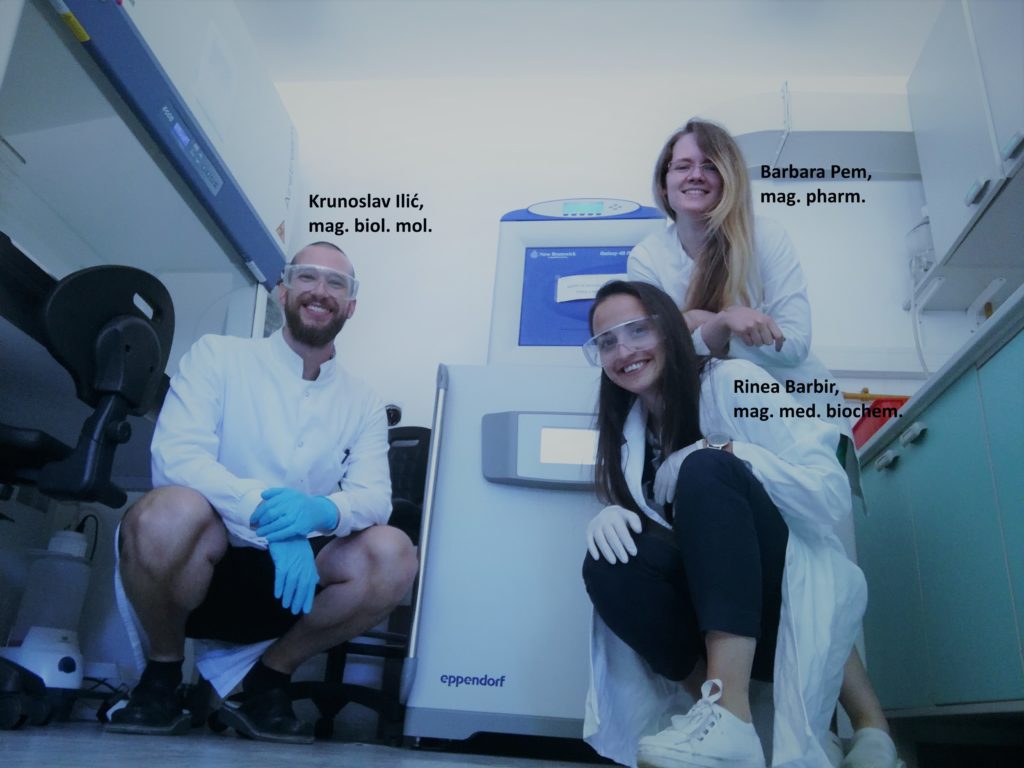The COST action CA17140 Work group 2 online conference was held on June 22nd and 23rd 2021, to present the latest accomplishments of the action Nano2Clinic: Cancer Nanomedicine – from the bench to the bedside. Work group 2 focuses on the physico-chemical characterization and quality control of nanopharmaceutics.
Continue reading “COST action Nano2Clinic online conference”Thesis defense – Barbara Vuković
Dr Barbara Vuković, Master of Biochemistry, defended her doctoral thesis that was made within the NanoFaceS project “Interaction of metallic nanoparticles with sulphur-containing biomolecules – implications for nano-bio interface”, under the co-menthorship of Dr Ivana Vinković Vrček and mentorship of Prof Vatroslav Šerić. Thesis defense was held on May 14 2021 at the School of Medicine, University of Osijek.
Continue reading “Thesis defense – Barbara Vuković”Thesis defense – Marija Milić
Dr Marija Milić, Master of Biochemistry, successfully defended her doctoral thesis that was made within the NanoFaceS project “Interaction of metallic nanoparticles with sulphur-containing biomolecules – implications for nano-bio interface”, under the co-menthorship of Dr Ivana Vinković Vrček and mentorship of Prof Vatroslav Šerić. Thesis defense was held on May 14 2021 at the School of Medicine, University of Osijek.
Continue reading “Thesis defense – Marija Milić”Start of the Phoenix project
11 project partners from academia and industry have joined forces in the PHOENIX project to create an Open Innovation Test Bed for nano-pharmaceuticals. PHOENIX (Pharmaceutical Open Innovation Test Bed for Enabling Nano-pharmaceutical Innovative Products) is a research project funded by EU’s Horizon2020 research programme and it aims at providing services to the market for the development, testing, safety assessment, GMP production and commercialization of nano-pharmaceuticals.
Continue reading “Start of the Phoenix project”Nano2Clinic webinar
On February 17th 2021 at 4 pm the first COST Action CA17140 Nano2Clinic webinar will be held. For the training session, Prof. Lajosh Balogh will give a lecture on “Manuscript preparation and publications – the basics.” For the dissemination session, Dr. Rinea Barbir (PhD student in the group of our WG2 leader Dr. Ivana Vinković Vrček and recipient of an STSM grant) will give a talk on “Steady-state fluorescence quenching method for evaluation of nano-bio interactions”. More information can be found on the official website.
Thesis topic defense – K. Ilić
On February 2nd 2021 at the Faculty of Pharmacy and Biochemistry, the public presentation of the thesis topic was held by PhD student Krunoslav Ilić. The proposed thesis title was “Evaluation of combined effect of silver and polystyrene nanoparticles on model immune cell lines”, supervised by Dr Ivan Pavičić and Prof Petra Turčić. The defense was held in front of the commission consisting of: Prof Anita Hafner, Prof Tin Weitner and Dr Dragomira Majhen.
Lara Zoric – Rector’s Award winner
Lara Zorić, student from Faculty of Pharmacy and Biochemistry has won the Rector’s Award for the academic year 2019./2020. Her paper “Development and validation of HPLC-FD method for the simultaneous determination of doxorubicin metabolites in the urine of rats” has been awarded in category A – “Individual scientific or artistic work”.
The paper is a result of research on projects Supramolecular Synthesis of Self-Assembled Functional Nanomaterials and Complex Chemical Systems (SUPeRNANO, IP-2018-01-6910) and Safe-by-Design Approach for Development of Nano-Enabled-Delivery Systems to Target the Brain – SENDER (HRZZ-PZS-2019-02-4323).
We want to congratulate Lara, her mentor dr. sc. Ruža Frkanec and her comentor doc. dr. sc. Davor Šakić on this major success and we are looking forward to new collaborations.
Thank You Mandis Pharm
The research team of the project NanoFaceS, led by Dr Ivana Vinković Vrček, would like to thank Mandis Pharm company for their generous monetary donation. The funds donated were invested in the purchase of the new incubator for cell culture experiments, which allowed for the continuation of our research.

Thesis topic defense – B. Pem
On July 7th 2020 at the Faculty of Pharmacy and Biochemistry, the public presentation of the thesis topic was held by PhD student Barbara Pem. The proposed thesis title was “Mechanism of interaction of endogenous biothiols with silver and gold nanoparticles”,supervised by Dr Ivana Vinković Vrček and Prof Valerije Vrček. The defense was held in front of the commission consisting of: Prof Mario Jug, Dr Ivana Perković and Dr Robert Vianello.
Research study in Germany – Rinea Barbir
From November 11th 2019 to June 1st 2020, PhD student Rinea Barbir was participating in a research study in Helmholtz zentrum Munich, Germany. The research stay was funded through the DAAD scholarship from the German Academic Exchange Service.
Rinea Barbir worked in the Unit for analytical biogeochemistry under the supervision of Prof Bernhardt Michalke. Her work included learning the techniques of capillary electrophoresis coupled with mass spectrometry and the development of a method for separating and analyzing the components of a protein corona on the surface of gold nanoparticles.